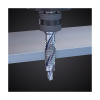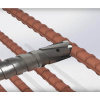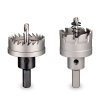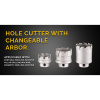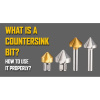How to Use a Step Drill Bit Properly?
Step drills are drill bits easy to cut and enlarge a wide range of holes on thin sheet metal, plastic and other materials at a lower speed. Due to the stepped design of multiple diameters, you can drill different-sized holes by one or two step drills.
Use an appropriate step drill in a right way can help you make good works. Before using it to make a hole, take a quick view for this article to check if there is something missing!
Know more information about: What is a step drill/ step bit/ step drill bit?
Menu
How to Use a Step Drill Bit Properly
Notice
Why the step drill bit overheat
Watch Step Drill Video
Support
[ How to Use a Step Drill Bit Properly ]
First. What do you need before drilling a hole?

Step drill:
Choose an appropriate step drill bit based on the material, final hole size, and the thickness of the material (thinner than the step depth). Additionally, inspect each step drill bits and tools for damage before using them.
Power tool:
Step drills are used with portable drilling machines, such as cordless drill drivers or rotary drills, and also drill press (pillar drill) that can accommodate the shank.
Cutting fluid:
To prevent overheating and reduce the drilling friction between step drill and material, it is recommended to add cutting fluid, lubricant and coolant, to keep the step drill bit cool.
Personal Protective Equipment:
Safe clothing: Please do not wear loose clothing, ties, necklaces or something that could be caught by the drill. Fitting clothing with short sleeves is a better choice.
Eye protection: During the process of drilling, small piece
of metal or wood debris and coolant liquid can cause damage to eyeballs
without putting safety glasses.
Hand protection: When handling the object, especially with a rough surface, it’s better to wear thick work gloves to prevent your hands from getting hurt. If using the step drill bit with drill press, please do not wear gloves.
Foot protection: It may have some sharp objects, cutting liquid or even tools fall to the floor when drilling the material. Therefore, it’s better wearing working shoes or boots to protect your feet from injury.
Good spirit:
Please do not start the drilling work if feeling tired or in a bad mood.
Second. Please Clamp the Object
Before the drilling work, don’t forget to hold the work securely to prevent it from slipping and spinning through the inward pressure of the step drill.
Third. Make a Center Mark (for step drills with normal tip)
Hit the center punch by the hammer to create a center mark at the location of the desired hole. The mark can help step drill bit catch the material so it will not shift to the wrong position when starting drilling.
If your step drill has a split-point tip which is sharp and non-slip, there’s no need to make a center mark.
Fourth. Drill a Pilot Hole (for larger step drills)
When using a larger step drill bit to make a new hole, it is necessary to drill a pilot hole to the smallest diameter of your larger step bit. You can use a pilot bit or small step drill to bore a pilot hole.
Fifth. Steps of Drilling the Hole
- Insert the step drill shank firmly to the chuck of your power tool without battery or plugging into power source.
- Add some lubricant to your step drill and also to the center mark on the surface of the hard material, such as metal sheet.
- Drill vertically in the desired position with low drill speeds and steady pressure.
- Give the step drill additional supply of cutting fluid (coolant) to cool it down.
- Slow down the drilling speed and reduce the force as you get to the desired hole.
- When reaching the hole size you need, chamfer the hole by the next bevel edge to get a clean surface.
Sixth. Clean Up
After drilling all of the holes you need, clean the step drill bit with a dry rag and then put it back to the drill bit storage case. Use magnetic chip collector to remove metal chips around the workplace. For other material, broom and vacuum are good tools to clean up the surface and ground.
[Notice]

-
Protection – clothing, eyes, hands, foot
-
Clamp the work – avoid shifting and spinning
-
Turn off the power – when inserting and removing the step
drill bit
-
Low Drilling speed – protect the step drill from damage
Why the step drill bit overheat?
- The step drill is blunt and dull.
- Drill in high speed for too long.
- Push with too much pressure or press the drill not hard enough.
- Not use cutting fluid (lubricant and coolant).
- The material is too hard for the step drill.
- If becoming overheat (red hot), this not only will destroy the step drill bit but also may burn the materials.
[Watch Step Drill Video]
[Support]

